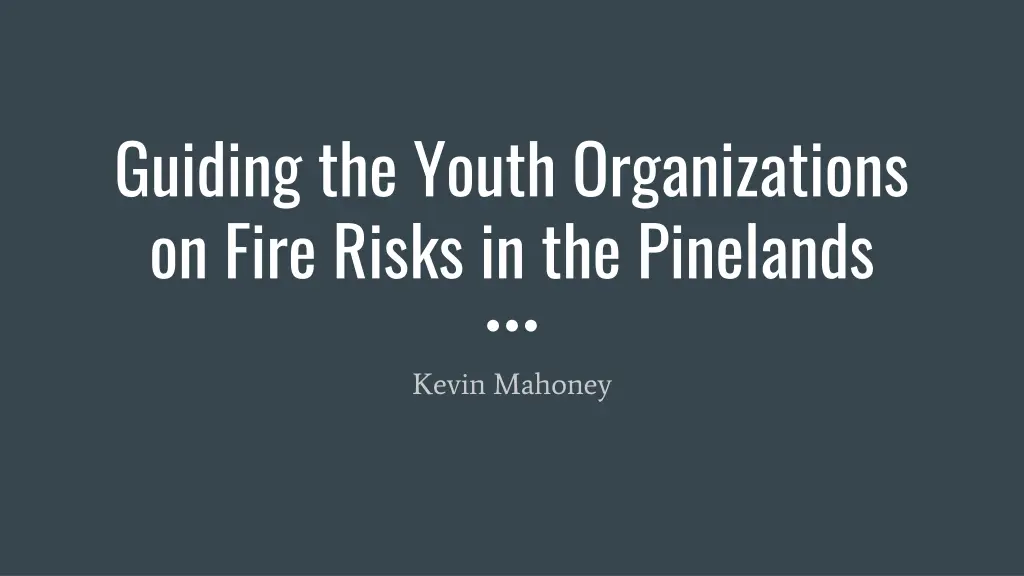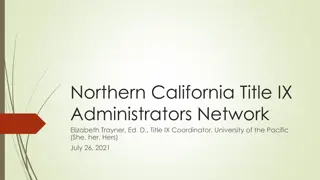
Understanding Forest Fire Risks in Pinelands: Causes, Impacts, and Solutions
Explore the increasing global trend of forest fires, causes behind them like warmer temperatures and human activities, specific risks in the Pinelands area of New Jersey, and factors contributing to fire risks such as changes in vegetation patterns and high ladder fuels.
Uploaded on | 0 Views
Download Presentation

Please find below an Image/Link to download the presentation.
The content on the website is provided AS IS for your information and personal use only. It may not be sold, licensed, or shared on other websites without obtaining consent from the author. If you encounter any issues during the download, it is possible that the publisher has removed the file from their server.
You are allowed to download the files provided on this website for personal or commercial use, subject to the condition that they are used lawfully. All files are the property of their respective owners.
The content on the website is provided AS IS for your information and personal use only. It may not be sold, licensed, or shared on other websites without obtaining consent from the author.
E N D
Presentation Transcript
Guiding the Youth Organizations on Fire Risks in the Pinelands Kevin Mahoney
The Increase in Forest Fires Increases in Global headlines about devastating forest fires How have forest fires events increased on a global scale? US Global Change Research Program notes a profound increase in forest fires in recent years According to Global Fire Watch (GFW), a number of areas in Europe north of the arctic circle saw significant fires during a 2 month period of 2018
What Do We Know About the Causes? Numerous sources such as NASA, the EPA, the NPS and GFW site causes being Warmer temperatures Droughts Drier soils 85% of US wildfires were caused by Human involvement (Short, 2017) Notable human causes: Unattended campfires discarded cigarettes Intentional acts of arson
What can We See on a Smaller Level? Wildfires in the Western US: 61% of forest fires have occurred from 2000 - 2017 (Weber) Noticeable shifts towards coniferous tree areas burning over time Significant detail if we look at the Eastern US The same areas burned repeatedly Figure 1. Wildfires Across the West (Weber)
Pinelands and Forest Fires How have forest fires changed in the New Jersey Pinelands? In May of 2021, over 1,000 acres in the Pinelands burned in one week Drier conditions have the entire state listed as high fire danger Why is it significant to study the Pinelands? The NJDEP states: Nutrient poor soil, acidic water and dry soil aid the growth of vegetation that thrive fire prone forests Region includes some of the largest unbroken tracts of forest in the East High probability of forest fires caused by highly flammable vegetation Home to 43 endangered or threatened animal species
What Can Add to the Risk? Groundwater withdrawals creating drier conditions Zhang and Bognar found a withdrawals changing what vegetation grows Changes in vegetation growth and patterns Areas containing high ladder fuels can increase fire spread (Skowronski, 2007) Vegetation patterns can predict watershed withdrawals (Laidig, 2010) Indicator species can be found along streams (Zampella, 1997) Invasive species killing vegetation and increasing fire fuels Spotted lantern moth
Why the Scouts? 8th grade reading level average among US (Stossel, 2012) Majority of youth organization members are at this level Environmentalism and Forestry at the foundation Community involvement is an important facet of these organizations
Guiding the Public By using a web app and web mapping to: Make the information easily accessible to the public Make the information clear through mapped data and overlay layers Provided pre-trip guides for identifying risk factors in the field Does education on environmental and ecological issues make an impact? Students benefit from educational travel programs for sustainability (Hale, 2021) Evidence shows education is most successful when focused on local and actionable aspects of climate change (Anderson, 2013)
Goals and Objectives 1. 2. Create a personal stake in local environmental issues 3. Track the groups using the web app through submitted information Develop a web app to disseminate new information
How are We Going to Build It? Where is the data going to be stored? Layers will be created and accessed from ArcGIS Online Where is the app going to be hosted? Heroku Libraries and packages used: ArcGIS API for JavaScript BootStrap
What Will the Map Include? Layers will include: Risk factors within the borders of the Pinelands Watershed Vegetation Pinelands Management Areas Analysis will focus on how these risk overlay With each other With campgrounds
What About the Education Aspect? The app will act as a pre trip guide and education tool covering: Where are the risk areas? What should we look out for when we get there? Specific vegetation Dry area characteristics Identifiers for stream pattern changes How do we keep from making things worse? Campsite Clean up Fire safety Responsible fuel collections for fire What can we do to help while we are out there?
How are We Going to Keep People Using it? Tying in learning objectives and field guide to merit badges or awards: Forestry Ecology Fire Safety Including project ideas or suggestions Clean ups Eagle scout projects Gold Award Projects
What Can Come From This? 1. 2. Introducing new learning objectives to a large portion of the public 3. Increase in a greater involvement of the public Clear representation of at risk zones Measuring Success: via tracking us through forms Developing quizzes to test for learning objectives
How Will We Get This Out There? Connecting with local troops and councils for the youth organizations Troops and groups meet weekly Councils meet on a monthly schedule 5 boy scout councils, 3 Girl Scout councils in New Jersey Upcoming geo-education presentation at AAG annual conference
Timeline For Development Phase 1 Phase 1 Phase 2 Phase 2 Phase 3 Phase 3 Data aggregation Layer development Map display development Alpha version of app Adjust based on testing Secondary Feature development Beta version of app Adjustments Beautify and finalize Present to local Troops Testing Testing
Development Further Down the Line Create automation for updating data and information Expanding the identification of risk factors Create an additional tool for people to record and report information to update the database of information Connecting with popular campgrounds and park officials
References Anderson, A. (2013). Climate Change Education for Mitigation and Adaptation. Journal of Education for Sustainable Development, 6(2), 191 206. https://doi.org/https://doi.org/10.1177/0973408212475199 Department of Agriculture. (n.d.). Spotted Lanternfly. Retrieved September 20, 2021, from https://www.nj.gov/agriculture/divisions/pi/prog/pests-diseases/spotted-lanternfly/ Environmental Protection Agency. (2021, April). Climate Change Indicators: Wildfires. Retrieved September 23, 2021, from https://www.epa.gov/climate-indicators/climate-change-indicators-wildfires Hale BW. Educating for the Environment: The Role of the Host Destination in Education Travel Programs. Sustainability. 2021; 13(15):8351. https://doi.org/10.3390/su13158351 Kinver, M. (2021, August 1). Then and now: The burning issue of wildfires. BBC News. Retrieved September 20, 2021, from https://www.bbc.com/news/science-environment-57946155 Kummer, F. (2021, May 18). 1,000 acres of New JERSEY Pine BARRENS burned this Week Amid 'exceptionally DRY' conditions. https://www.inquirer.com. Retrieved September 20, 2021, from https://www.inquirer.com/science/climate/new-jersey-pinelands-pine-barrens- 20210518.html Laidig, K. J., Zampella, R. A., Brown, A. M., & Procopio, N. A. (2010). Development of vegetation models to predict the potential effect of groundwater withdrawals on forested wetlands. Wetlands, 30(3), 489 500. https://doi.org/10.1007/s13157-010-0063-5 NASA. (n.d.). Fire. NASA. Retrieved September 21, 2021, from https://earthobservatory.nasa.gov/global-maps/MOD14A1_M_FIRE New Jersey Pinelands Commission. (2021, August 24). Pinelands Facts. Retrieved September 21, 2021, from https://www.nj.gov/pinelands/infor/fact/Pinelands%20Facts.pdf Pinelands fire facts. (n.d.). Retrieved September 22, 2021, from https://www.nj.gov/pinelands/infor/educational/curriculum/pinecur/pff.htm Short, Karen C. 2017. Spatial wildfire occurrence data for the United States, 1992-2015 [FPA_FOD_20170508]. 4th Edition. Fort Collins, CO: Forest Service Research Data Archive. https://doi.org/10.2737/RDS-2013-0009.4 SKOWRONSKI, N., CLARK, K., NELSON, R., HOM, J., & PATTERSON, M. (2007). Remotely sensed measurements of forest structure and fuel loads in THE PINELANDS of New Jersey. Remote Sensing of Environment, 108(2), 123 129. https://doi.org/10.1016/j.rse.2006.09.032 Stossel, L. M., Segar, N., Gliatto, P., Fallar, R., & Karani, R. (2012). Readability of patient education materials available at the point of care. Journal of General Internal Medicine, 27(9), 1165 1170. https://doi.org/10.1007/s11606-012-2046-0 U.S. Department of the Interior. (n.d.). Wildfire causes and evaluations (U.S. National PARK SERVICE). National Parks Service. Retrieved September 20, 2021, from https://www.nps.gov/articles/wildfire-causes-and-evaluation.htm Weber, K. T., Yadev, R., Davis, J., Blair, K., Schnase, J., Carroll, M., & Gill, R. (n.d.). Geography of Wildfires Across the West. The NASA RECOVER DSS. Retrieved September 22, 2021, from https://giscenter.isu.edu/research/Techpg/nasa_RECOVER/pdf/GeographyWildfires.pdf Zhang, Y., Miao, Z., Bognar, J. et al. Landscape Scale Modeling of the Potential Effect of Groundwater-level Declines on Forested Wetlands in the New Jersey Pinelands. Wetlands 31, 1131 1142 (2011). https://doi.org/10.1007/s13157-011-0223-2 Zampella, R. A., & Laidig, K. J. (1997). Effect of watershed disturbance on Pinelands Stream vegetation. Journal of the Torrey Botanical Society, 124(1), 52 66. https://doi.org/10.2307/2996598
Questions Include brief summary or create an aid to assist audience (keep to 1 slide)


